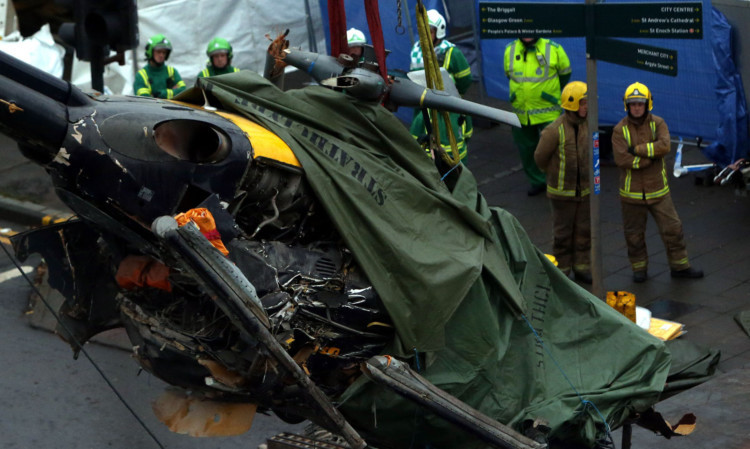The exact cause of the police helicopter tragedy in Glasgow which claimed nine lives is still unclear following an interim report by investigators.
The helicopter crashed on to the flat roof of the The Clutha Vaults bar on the night of November 29 with a high rate of descent and with low or negligible forward speed, a special bulletin from the Air Accidents Investigation Branch (AAIB) revealed.
But the AAIB added that the weather was good, that so far there was no evidence of engine or gearbox failure and that “all significant components were present” at the time of impact.
In addition, the helicopter still had 95 litres of the 400kg of fuel that it had taken off with from Glasgow City Heliport.
The AAIB said the twin-engine Eurocopter EC 135 aircraft had no flight recorders, nor was required to do so. But there were some non crash-protected system recordings that could be studied along with radio communications and closed circuit TV recordings.
Saying that the investigation would continue, the AAIB promised to report any significant developments.
The pilot of the helicopter David Traill, 51, and his two passengers – police officers Kirsty Nelis, 36, and Tony Collins, 43 – were killed in the crash as were six people inside the pub.
Today’s bulletin traced the events of the Friday night of the crash. In good visibility and light winds, the helicopter had left Glasgow City Heliport at 8.45pm, gone first to the south side of the city, then on to Dalkeith in Midlothian about 40 miles away before returning to Glasgow.
The pilot had requested and received clearance from air traffic controllers to re-enter the Glasgow control zone at 10.18pm and there were no further radio transmissions received from him.
The AAIB added that radar contact with the helicopter was lost at 10.22pm.
The report went on: “Around this time, the helicopter was seen and heard by a witness who described hearing a noise like a loud ‘misfiring car’, followed by silence.
“He then saw the helicopter descend rapidly. It crashed through the roof of The Clutha Bar, a single-storey building on Stockwell Street in central Glasgow.”
The report said that initial evidence indicated that the helicopter struck the flat roof of the pub “with a high rate of descent and low/negligible forward speed”.
The AAIB went on: “Preliminary examination showed that all main rotor blades were attached at the time of the impact but that neither the main rotor nor the fenestron tail rotor (a form of protected tail rotor) were rotating.
“The impact forces caused the roof of the bar to collapse and (the) helicopter entered the building, its forward section coming to rest on and amongst building debris.
“Very extensive damage and disruption of the helicopter structure and components resulted from the impact forces and from contact with the collapsing building. The helicopter did, however, remain approximately upright.”
The bulletin described how investigators had examined the helicopter on the site and how the building was shored up and the helicopter removed to the AAIB headquarters at Farnborough in Hampshire.
The report went on: “Initial assessment provided no evidence of major mechanical disruption of either engine and indicated that the main rotor gearbox was capable of providing drive from the No 2 engine turbine to the main rotor and to the fenestron drive shaft.”
The pilots’ union Balpa said: “The information published by the AAIB today is a helpful first assessment of the facts of the case and suggests there is no evidence of mechanical engine failure.
“But, unfortunately, at this stage, there is not much more to go on and the reasons behind the crash are, in truth, far from clear. The AAIB must be given the time to complete its thorough investigation and we have faith in their ability to do so.”
